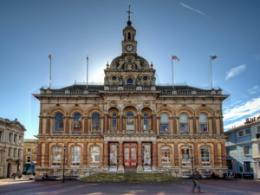
One of Ipswich’s most iconic buildings, the Town Hall, has its 150th anniversary this year and there is a programme of events to celebrate the occasion.
A public open day on Sunday 28th January (the exact anniversary date) will feature exhibitions, tours of the Mayor’s Parlour, a special twist to the annual Burn’s Supper and an opportunity to win a “community takeover” of part of the building.
There will even be a birthday cake with 150 candles.
Tea dances, guided walks, a Teddy Bear’s picnic and digitalised story-telling sessions are all planned as celebrations continue throughout the year.
The present Town Hall was opened by the Mayor, John Patteson Cobbold, on 28th January 1868 but the history goes back much further: it stands on the site of St Mildred’s Chapel, which is mentioned in the Domesday Book. In 1421, the chapel became a court and became known as the Guildhall or Moot Hall (council meeting place). A new façade was built in 1494 before work started on a new modelled Town Hall in the early 19th Century. The rest, as they say, is history.
Building costs were more modest in those days … the Town Hall cost just £16,000 to construct.
The Mayor of Ipswich, Councillor Sarah Barber, said: “I am sure many Ipswich people will come along to the open day to celebrate this special anniversary and take part in the other events this year. The Town Hall is still one of our most important building and you do get a sense of history here, particularly during council meetings which follow 500 years of civic activity and serving the town.”